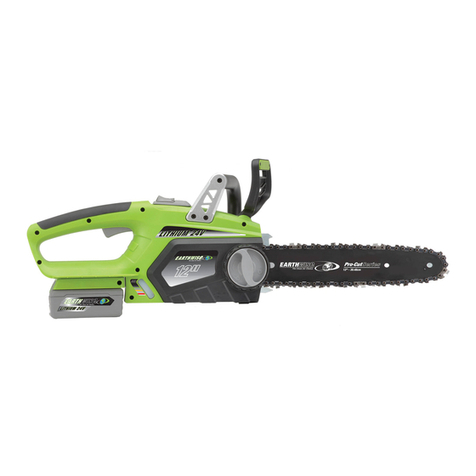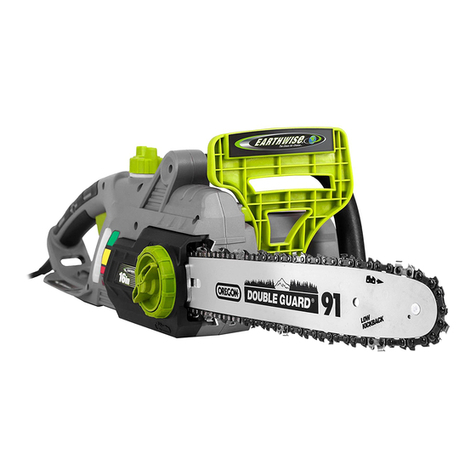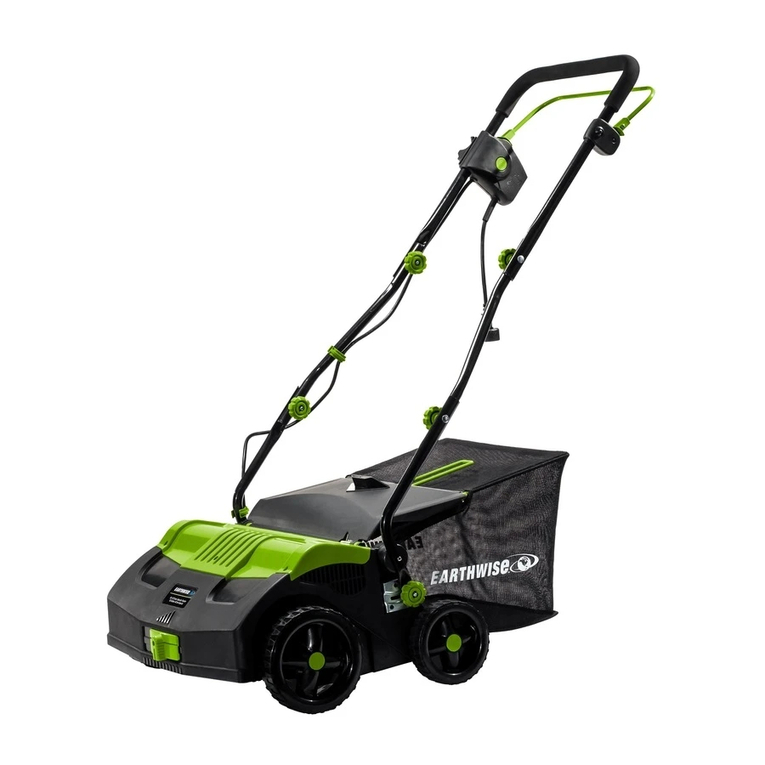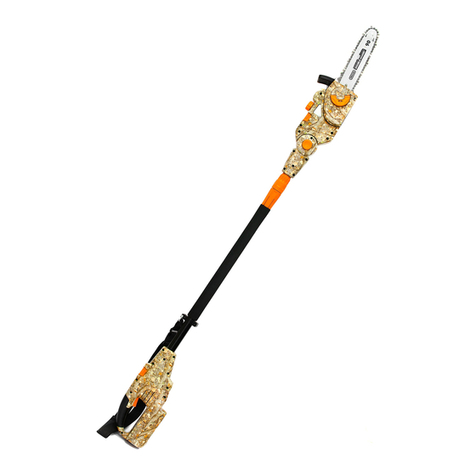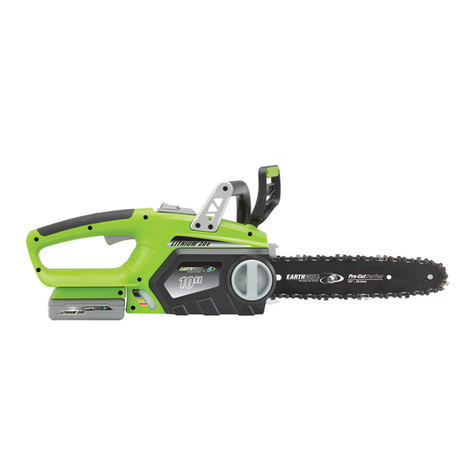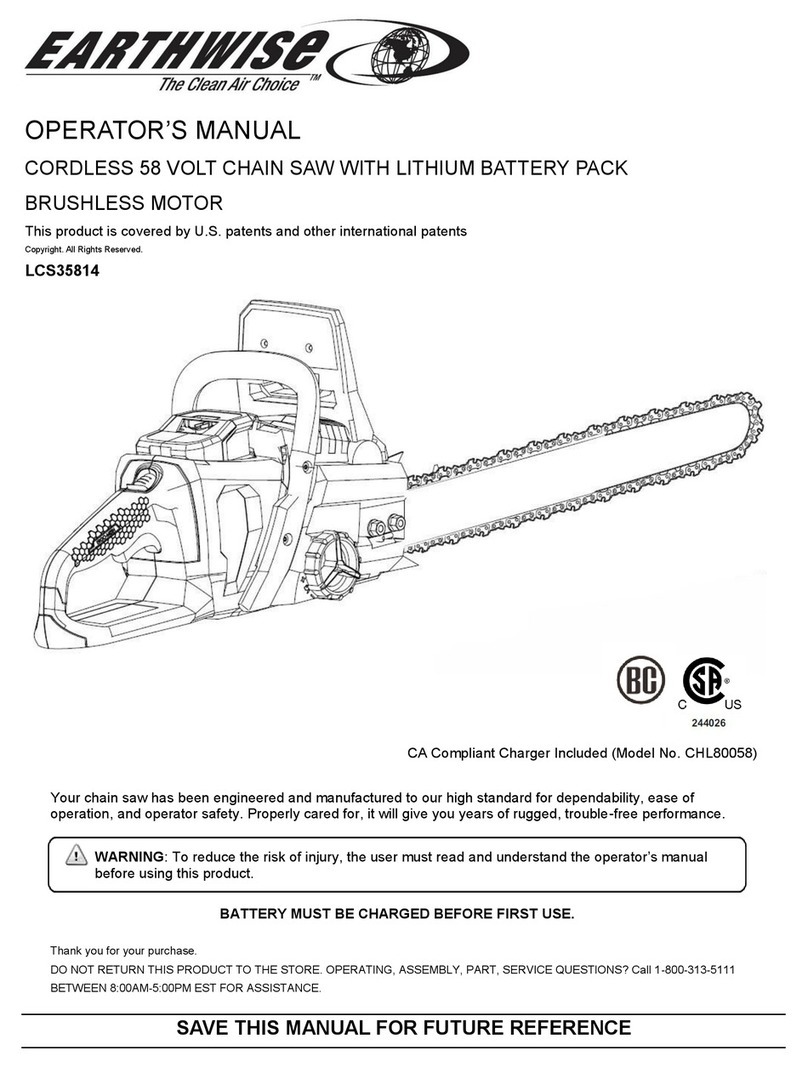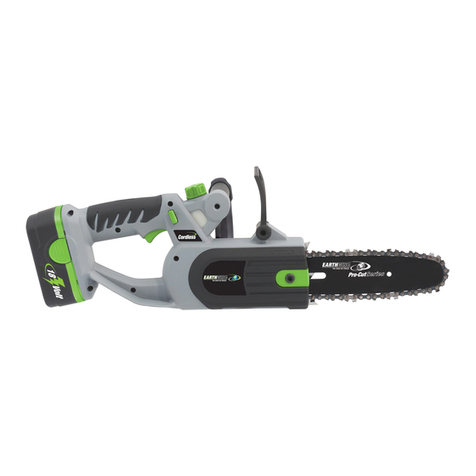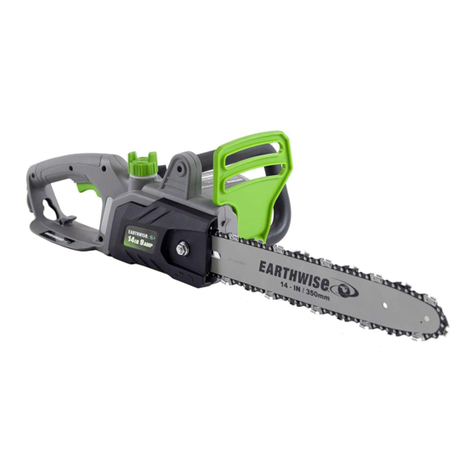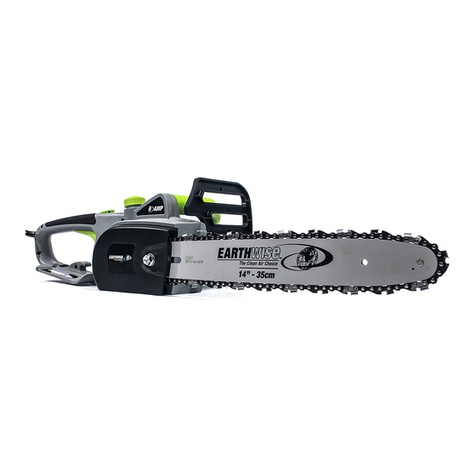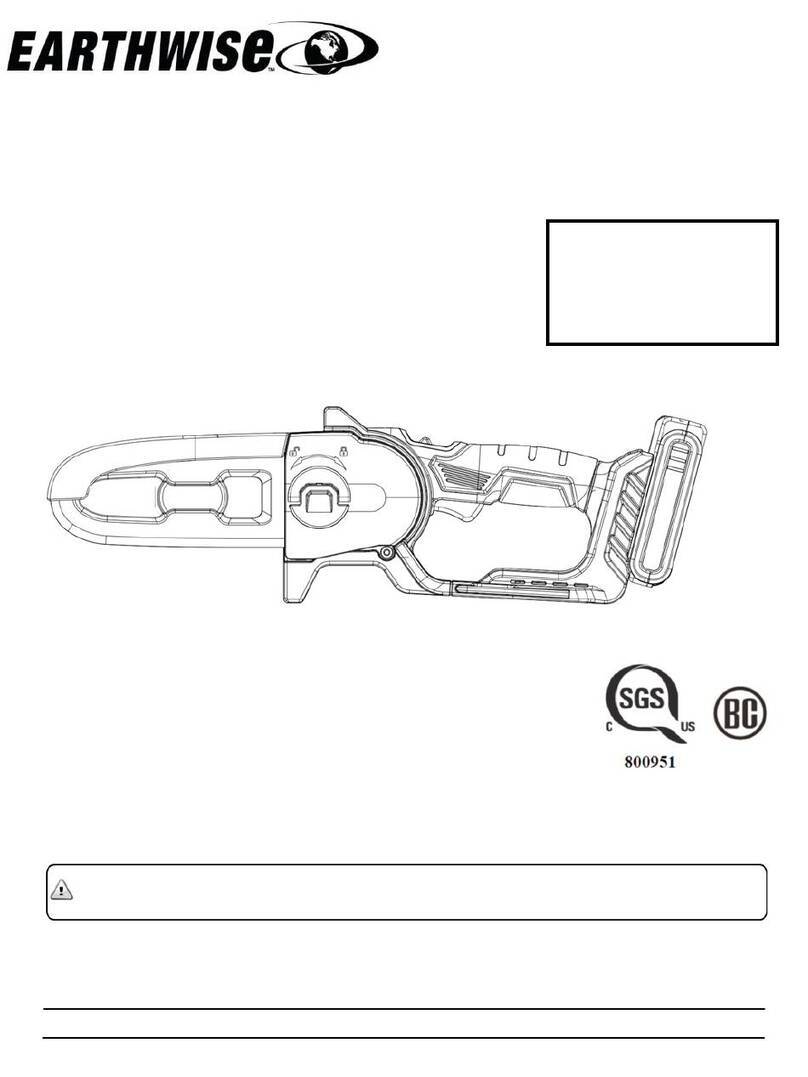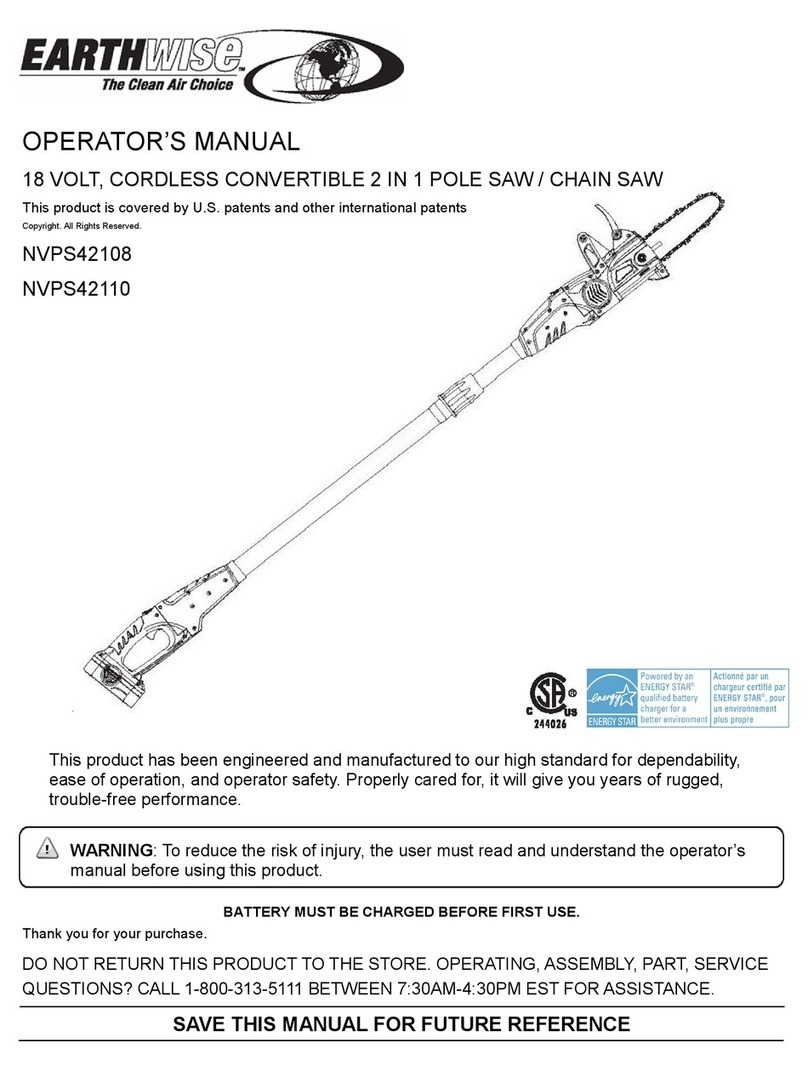OPERATING
TO TURN THE TOOL ON
Push the lock button in with your thumb and then squeeze the trigger
with your fingers. (Once the tool is running, you can release the lock
button). To turn the tool OFF, release the trigger.
WARNING: To guard against injury, observe the following:
Read instruction manual before using, save instruction
manual.
Keep hands away from chain.
.HHSKDQGVRQKDQGOHV'RQ¶WRYHUUHDFKA good, firm grip on the saw with both hands will help you maintain
FRQWURO'RQ¶WOHWJR*ULSWKHUHDUKDQGOHZLWK\RXUULJKWKDQGZKHWKHUyou are right or left handed. Wrap the fingers of your left hand over
and around the front handlebar, and your left thumb under the front
handlebar.
WARNING: Do not operate chain saw in a tree, on a ladder, or on a
scaffold; this is extremely dangerous.
CAUTION: Chain coasts after turned off.
Do not use under wet conditions.
Use extreme caution when cutting small size brush, saplings or limbs
under tension, because slender and tense material may catch the saw
and be whipped toward you, pull you off balance or spring back.
Do not cut vines and/or small underbrush.
WARNING: Do not allow familiarity with this type of tool to make you
careless. Remember that a careless fraction of a second is sufficient to
inflict serious injury.
Before you start the unit, make sure the chain saw is not contacting any
object.
WARNING: Do not cut trees near electrical wires or buildings.
Make sure you follow the instructions in maintenance for putting oil in
the chain saw.
CAUTION: Failure to lubricate the chain will cause damage to the
bar and chain. Use only a good quality bar and chain oil or, if not
available, unused SAE 30 weight motor oil may be substituted. One
minute of use will consume approx. 0.2 fl. oz. (6ml) of oil.
NOTE: It is normal for oil to seep from the saw when not in use. To
prevent seepage, empty the oil tank after each use. When storing the
unit for a long period of time (3 months or longer) be sure the chain is
lightly lubricated; this will prevent rust on the chain and bar sprocket.
WARNING: Do Not use the chain saw with any type of accessory or
attachment. Such usage might be hazardous.
WARNING: Kickback may occur when the moving chain contacts an
object at the upper portion of the tip of the guide bar or when the wood
closes in and pinches the chain saw in the cut. Contact at the upper
portion of the tip of the guide bar can cause the chain to dig into the
object and stop the chain for an instant. The result is a lightening fast,
reverse reaction which kicks the guide bar up and back toward the
operator. If the chain saw is pinched along the top of the guide bar,
the guide bar can be driven rapidly back toward the operator. Either
of these reactions can cause loss of saw control which can result in
serious injury. Do not rely exclusively upon the safety devices built into
the saw. As a chain saw user, you should take several steps to keep
your cutting jobs free from accident or injury.
The following precautions should be followed to minimize
kickback:
1. Always grip the saw firmly with both hands. Hold the saw firmly
with both hands when the unit is running. Place your right hand
on the rear handle and your left hand on the front handle with
your thumbs and fingers encircling the chain saw handles. A
firm grip together with a stiff left arm will help you maintain
control of the saw if kickback occurs.
2. Make sure that the area in which you are cutting is free from
obstructions. Do not let the nose of the guide bar contact a log,
branch, fence or any other obstruction that could be hit while
you are operating the saw.
3. Always cut with the unit running at full speed. Fully squeeze the
throttle trigger and maintain a steady cutting speed.
Push and Pull ±This reaction force is always opposite to the direction
the chain is moving where wood contact is made. Thus, the operator
must be ready to control the PULL when cutting on the bottom edge
of the bar, and PUSH when cutting along the top edge.
Wear non-slip gloves for maximum grip and protection.
Proper Cutting Stance
Weight should be balanced with both feet on solid ground.
.HHSOHIWDUPZLWKHOERZORFNHGLQD³VWUDLJKWDUP´SRVLWLRQWRwithstand any kickback force.
Your body should always be to the left of the chain line.
Basic Cutting Procedure
Small trees up to 6-7inches in diameter are usually cut in a single cut.
Large trees require notch cuts. Notch cuts determine the direction the
tree will fall.
WARNING: If the tree starts to fall in the wrong direction, or if the
saw gets caught or hung up during the fall, leave the saw and save
yourself.
WARNING: Periodically glance at the top of the tree during the
back-cut to assure the tree is going to fall in the desired direction.
Practice cutting a few small logs using the following technique to
JHWWKH³IHHO´RIXVLQJWKHVDZEHIRUH\RXEHJLQDPDMRUVDZLQJoperation.
Take the proper stance in front of the wood with the saw off.
Squeeze the trigger and let the chain accelerate to full speed before
entering the cut.
Hold the saw firmly with both
hands. Always keep your left
hand on the front handle and
your right hand on the rear
handle so that your body is to
the left of the chain line.
Keep the unit running the
entire time you are cutting,
maintain a steady speed.
Allow the chain to cut for you; exert only light downward pressure. If
you force the cut, damage to the bar, chain, or unit can result.
Do not put pressure on the saw at the end of the cut.
When felling a tree, keep everyone a safe distance from the cutting
area. During felling operations, the safe distance should be at least
twice the height of the largest trees in the felling area. If the tree
makes contact with any utility line, the utility company should be
notified immediately.
Always cut with both feet on solid ground to prevent being pulled off
balance.
Do not cut above chest height, as a saw held higher is difficult to
control against kickback forces.
6
